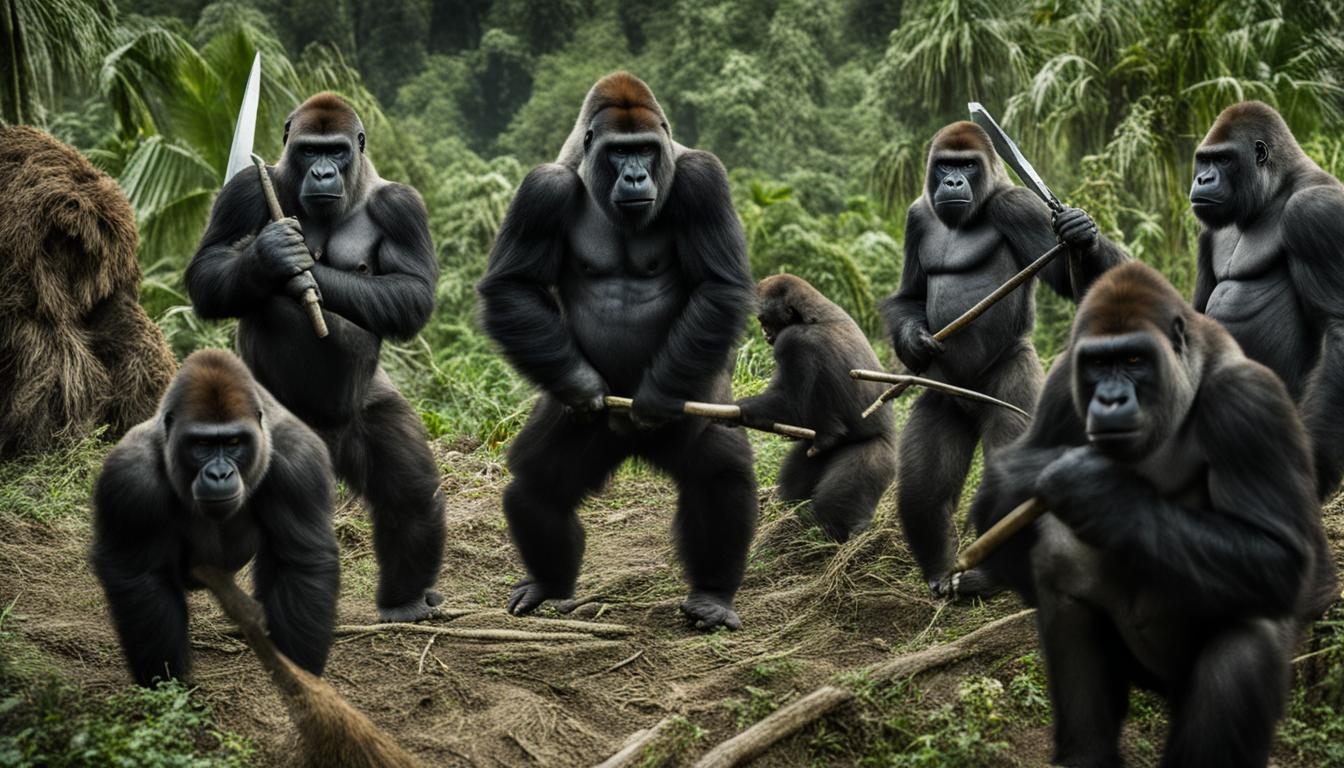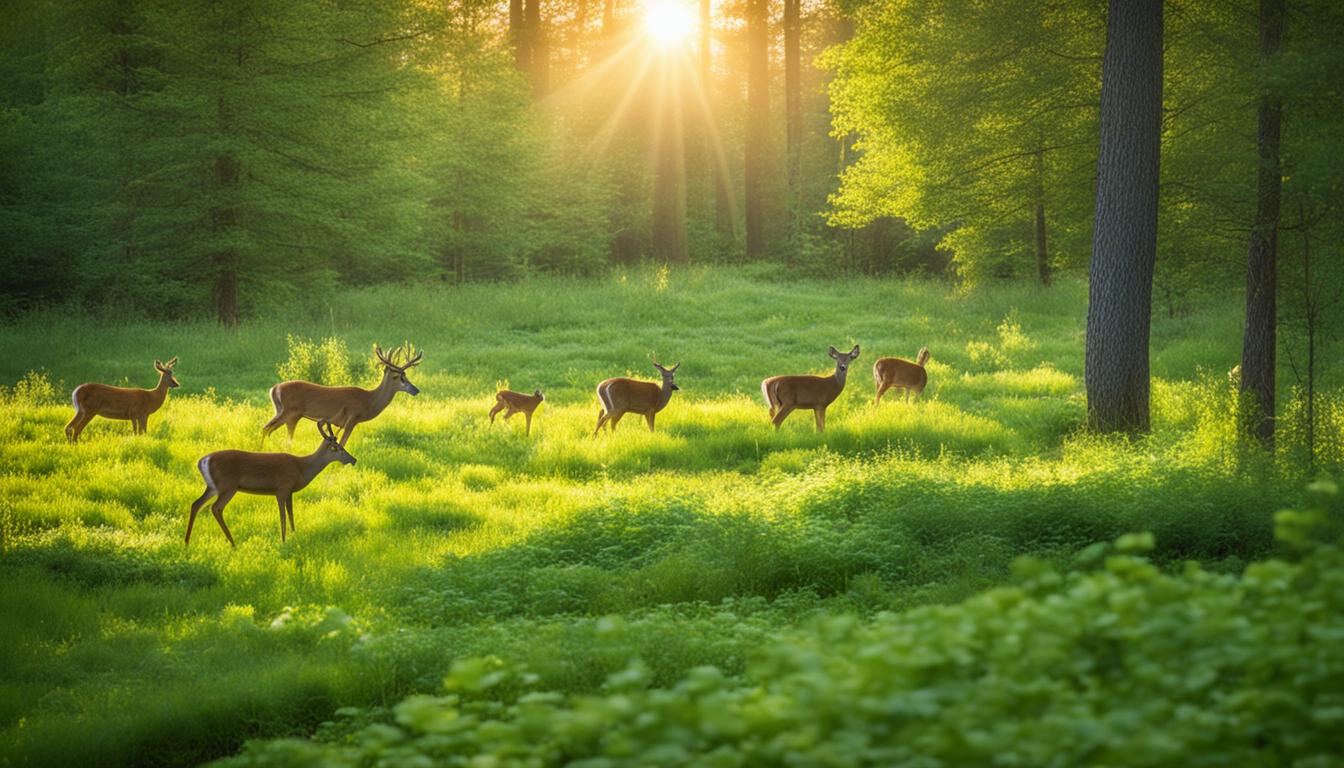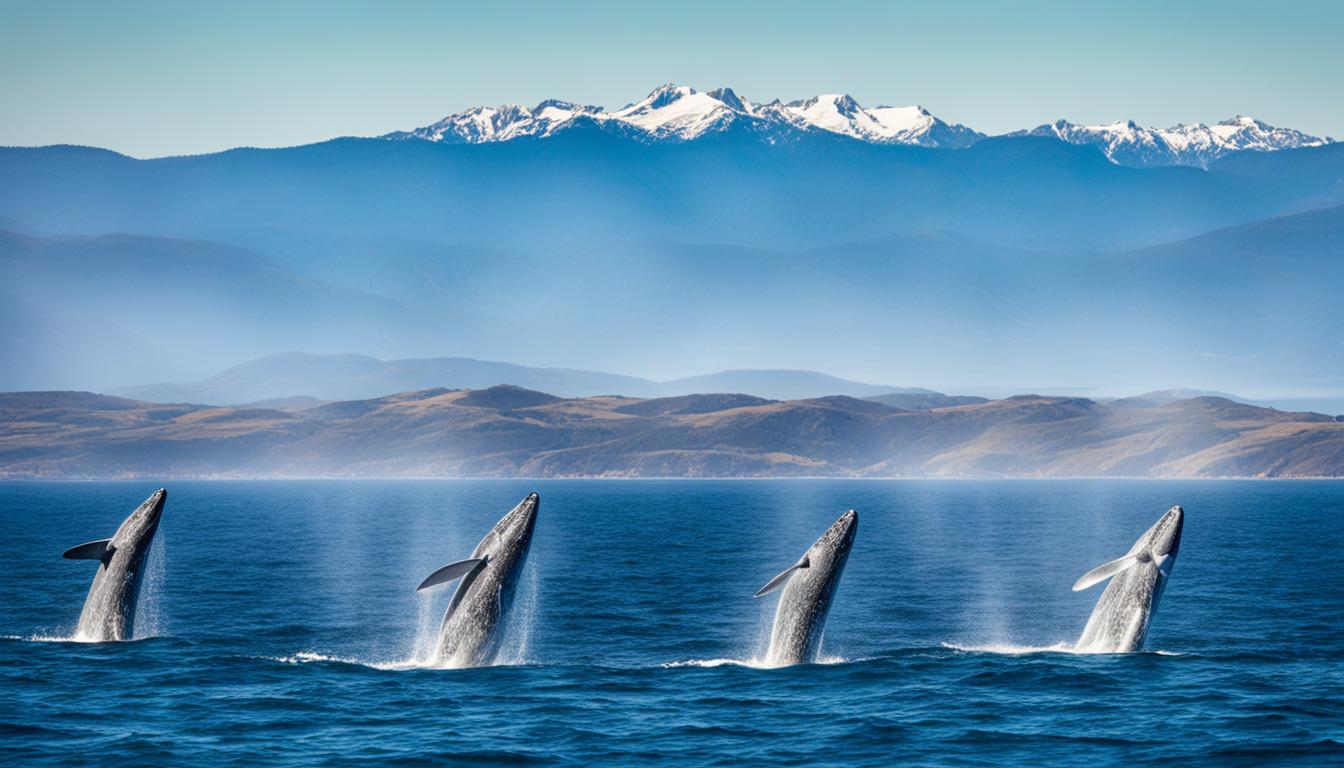Gorilla-human conflicts are posing significant threats to gorilla populations, impacting their survival and endangering their future. These conflicts arise from various factors, including habitat loss and fragmentation, poaching, diseases, and civil unrest. The decline in gorilla populations, especially among mountain gorillas, is alarming and necessitates a deeper understanding of the implications of these conflicts for primate conservation efforts.
As human activities continue to encroach upon gorilla habitats, the behavior and well-being of these magnificent creatures are severely affected. The loss and degradation of their natural habitats, driven by mining, logging, and agriculture, disrupt their delicate ecosystems and fragment their populations. In addition, the illegal trade of gorilla body parts and hunting for bushmeat further contribute to the declining numbers of gorillas.
It is crucial to implement effective conflict management strategies and promote coexistence with gorillas to mitigate these impacts. Conservation efforts focused on protecting gorilla habitats, resolving conflicts, and finding sustainable alternatives for local communities are key. By investing in tourism and raising awareness about the importance of gorilla conservation, we can foster a harmonious relationship between humans and these awe-inspiring primates.
The future of gorilla populations depends on our collective conservation efforts. Despite the challenges they face, there is hope for their survival. Preserving their forest habitats, addressing the underlying causes of conflicts, and raising awareness about their importance are essential steps towards ensuring the long-term survival of gorillas. Let us join hands in primate conservation and protect these incredible creatures for generations to come.
Impacts of Human-Gorilla Conflicts on Gorilla Populations
Gorilla populations are increasingly being affected by conflicts with humans, which have significant implications for their survival. These conflicts arise due to various factors, including habitat loss and degradation, poaching, and civil unrest. Understanding the impacts of these conflicts is crucial for effective primate conservation efforts.
The primary impact of human-gorilla conflicts is the loss and degradation of gorilla habitats. Activities such as mining, logging, and agriculture lead to the destruction of their natural habitats, fragmenting gorilla populations. This fragmentation not only isolates gorilla groups but also increases the risks of inbreeding and disease transmission among them. Additionally, the illegal trade of gorilla body parts and poaching for bushmeat further contribute to the decline in population numbers.
To mitigate these impacts, effective conflict management strategies and promoting coexistence with gorillas are essential. This entails implementing measures to minimize habitat destruction and degradation, such as sustainable land-use practices and protected areas. It also involves addressing the root causes of conflicts, such as poverty and lack of alternative livelihood options for local communities. By fostering coexistence between humans and gorillas, we can strive towards a future where both species can thrive.
| Impacts of Human-Gorilla Conflicts on Gorilla Populations | |
|---|---|
| Impact | Description |
| Habitat Loss and Degradation | Activities like mining, logging, and agriculture result in the destruction and fragmentation of gorilla habitats, isolating populations and increasing the risks of inbreeding and disease transmission. |
| Poaching and Illegal Trade | The illegal trade of gorilla body parts and poaching for bushmeat contribute to the decline in gorilla populations, further endangering their survival. |
| Conflict Management Strategies | Effective conflict management strategies, including sustainable land-use practices and protected areas, are crucial for minimizing the impacts of human-gorilla conflicts. |
| Promoting Coexistence | Fostering coexistence between humans and gorillas through education, awareness, and addressing socioeconomic factors can help mitigate the impacts of conflicts and protect gorilla populations. |
Quotes:
“By minimizing habitat destruction and promoting coexistence, we can ensure the long-term survival of gorillas and protect their populations for future generations.”
- Implications of habitat loss and fragmentation due to human activities
- Effects of poaching and illegal trade on gorilla populations
- Importance of effective conflict management strategies
- Promoting coexistence with gorillas as a key conservation measure
Causes of Human-Gorilla Conflicts
Gorilla behavior, habitat degradation, hunting, and poaching are key factors contributing to human-gorilla conflicts.
Gorillas, both mountain gorillas and other species, are known for their territorial nature. When their habitats are encroached upon by human activities, conflicts between gorillas and humans can arise. These conflicts can be triggered by the gorillas’ protective instincts and their need to defend their territory and resources. Understanding gorilla behavior and their natural range is crucial for minimizing the potential for conflicts.
Habitat degradation plays a significant role in exacerbating human-gorilla conflicts. Activities such as mining, commercial logging, and agriculture result in the destruction and fragmentation of gorilla habitats. This reduces the availability of suitable living spaces for gorillas and increases their vulnerability to conflicts with humans. By addressing habitat degradation, we can help reduce the likelihood of these conflicts occurring.
Hunting and poaching are also major causes of human-gorilla conflicts. Gorillas are often targeted for bushmeat, which is consumed as a source of protein in some communities. Additionally, the illegal trade of gorilla body parts further contributes to the endangerment of gorilla populations. Strict enforcement of anti-poaching laws and raising awareness about the importance of gorilla conservation are essential for combating these issues.
Remedies for mitigating gorilla conflicts
Gorilla conservation is a critical endeavor aimed at preserving the survival of these magnificent creatures and mitigating conflicts between humans and gorillas. Various strategies have been implemented to address the root causes of gorilla conflicts and promote coexistence. By investing in effective conflict resolution measures and finding sustainable alternatives for local communities, we can work towards a future where gorillas and humans can thrive together.
One of the key approaches to gorilla conservation is the protection and preservation of their habitats. This involves implementing measures to reduce habitat degradation caused by activities such as mining, commercial logging, and agriculture. By securing their natural living spaces, we can ensure the long-term viability of gorilla populations and minimize conflicts resulting from habitat loss and fragmentation.
“Conservation is a state of harmony between men and land.” – Aldo Leopold
An important aspect of mitigating gorilla conflicts is finding sustainable solutions for local communities that rely on the same resources as gorillas. By providing alternative livelihood options, such as eco-tourism or sustainable agriculture practices, we can reduce dependency on activities that directly impact gorilla habitats. This not only benefits local communities but also creates economic incentives for the conservation of gorillas and their habitats.
Table: Examples of Gorilla Conservation Strategies
| Conservation Strategy | Description |
|---|---|
| Habitat Protection | Implementing measures to reduce habitat degradation and secure gorilla habitats |
| Community Engagement | Engaging and educating local communities about gorilla conservation and providing sustainable alternatives |
| Anti-Poaching Efforts | Strengthening anti-poaching initiatives to prevent the illegal hunting and trade of gorillas |
| Research and Monitoring | Conducting scientific research and monitoring to better understand gorilla behavior and population dynamics |
| International Collaboration | Collaborating with international organizations and governments to support gorilla conservation efforts |
Gorilla conservation is a complex task that requires the collective efforts of governments, conservation organizations, local communities, and individuals. By implementing these and other strategies, we can contribute to mitigating gorilla conflicts, protecting their habitats, and ensuring a brighter future for these incredible creatures.
The future of gorilla populations
Gorilla populations, particularly mountain gorillas, face numerous challenges that threaten their survival. However, through dedicated primate conservation efforts, there is hope for the future of these majestic creatures. Preserving their forest habitats, raising awareness about their importance, and addressing the underlying causes of conflicts are crucial for ensuring the long-term survival of gorillas.
Conservation initiatives have already shown promising results in increasing the number of mountain gorillas. For example, the combined efforts of local communities, government agencies, and international organizations have led to a significant rise in their population over the past few decades. However, continued efforts are necessary to sustain this progress and further protect gorilla populations.
One key aspect of securing the future of gorillas is the preservation of their forest habitats. Ensuring that these habitats remain intact and free from destructive activities such as logging, mining, and agriculture is vital for providing gorillas with suitable living spaces. Additionally, implementing measures to mitigate the effects of climate change on their habitats will be crucial for their long-term survival.
Raising awareness about the importance of gorilla conservation is another essential step in securing their future. By educating people about the ecological significance of gorillas and the threats they face, we can foster a sense of responsibility and encourage individuals to contribute to conservation efforts. This can be done through educational campaigns, eco-tourism initiatives, and community outreach programs.
Addressing the underlying causes of human-gorilla conflicts is also crucial for the future of gorilla populations. This involves implementing effective conflict resolution strategies and promoting coexistence between humans and gorillas. By finding sustainable alternatives for local communities, such as providing income-generating opportunities through eco-tourism, we can reduce their reliance on activities that contribute to conflicts.
The future of gorilla populations ultimately depends on our collective conservation efforts. By preserving their forest habitats, raising awareness about their importance, and addressing the underlying causes of conflicts, we can ensure that these magnificent creatures continue to thrive in the wild. Together, we can contribute to primate conservation and secure a brighter future for mountain gorillas and other gorilla species.

Table: Comparison of Mountain Gorilla Populations
| Year | Population | Conservation Efforts |
|---|---|---|
| 1970 | Approximately 250 | Limited conservation efforts, high levels of poaching |
| 1990 | Approximately 620 | Increased conservation awareness, establishment of protected areas |
| 2010 | Approximately 880 | Dedicated conservation initiatives, community involvement |
| 2021 | Approximately 1,063 | Continued conservation efforts, sustainable tourism |
Conclusion
Human-gorilla conflicts have significant implications for gorilla populations, but through effective conservation strategies and conflict resolution, it is possible to mitigate these conflicts and ensure the survival of gorillas. Coexistence with gorillas and protecting their habitats are crucial for their long-term survival. By raising awareness and taking collective action, we can contribute to primate conservation efforts and protect these magnificent creatures for future generations.
Are the adaptions of gorillas to their environments affected by human-gorilla conflicts?
Human-gorilla conflicts can indeed impact gorillas’ environmental adaptation techniques. Encroachment on their habitats and disruption of their natural behaviors can hinder their ability to effectively adapt to their surroundings. Conservation efforts and reducing conflict can help gorillas thrive in their environments.
FAQ
How do human-gorilla conflicts impact gorilla populations?
Human-gorilla conflicts have significant impacts on gorilla populations, including habitat loss, fragmentation, inbreeding, disease, and declining numbers.
What are the impacts of human-gorilla conflicts on gorilla populations?
Human-gorilla conflicts result in habitat loss, degradation, poaching, and illegal trade, which contribute to declining gorilla population numbers.
What are the causes of human-gorilla conflicts?
Gorilla behavior, including territorial nature, combined with habitat degradation and hunting/poaching for bushmeat and body parts, contribute to human-gorilla conflicts.
What are the remedies for mitigating gorilla conflicts?
Conservation initiatives, conflict resolution, promoting coexistence with gorillas, and finding sustainable alternatives for local communities help mitigate human-gorilla conflicts.
What is the future of gorilla populations?
The future of gorilla populations depends on collective conservation efforts, preserving their habitats, raising awareness, and addressing the underlying causes of conflicts.
What is the importance of addressing human-gorilla conflicts?
By addressing human-gorilla conflicts, we can protect gorilla populations, foster coexistence, and contribute to primate conservation efforts for future generations.











